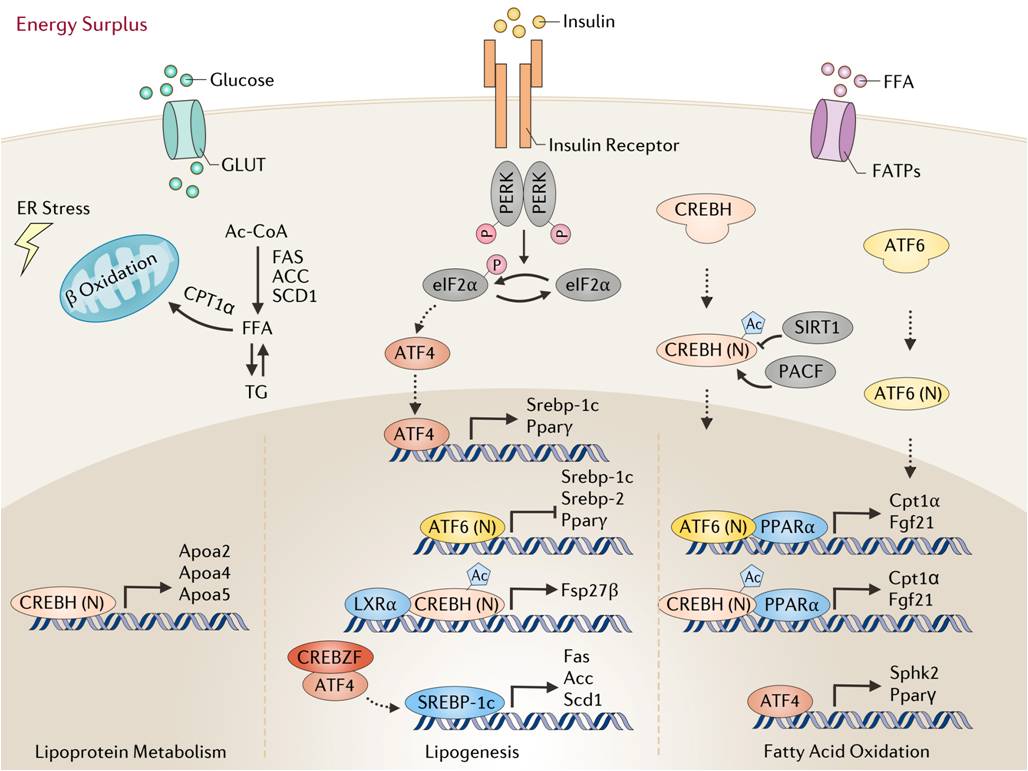Perspective for Diabetes on Regulation of Hepatic Metabolism and Cell Growth by ATF/CREB Family
The liver plays a central role in metabolic homeostasis. Deregulation of glucose and lipid metabolism predisposes to the development of metabolic diseases, such as insulin resistance, type 2 diabetes and nonalcoholic fatty liver disease (NAFLD), and increases the risk of developing several types of cancers, such as hepatocellular carcinomas (HCC). Aberrant signaling regulated by the transcription factor or cofactor in response to nutrients and growth factors play pivotal roles in the development of these disorders.
The ATF/CREB member is a conserved family of proteins that share a basic-region leucine zipper (bZIP) domain composed of both a DNA-binding basic region and a leucine zipper dimerization motif. More than 20 proteins named with an ATF/CREB prefix have been identified in mammals. The family proteins form the homodimer or selective heterodimer with each other or with other bZIP proteins. Extensive researches have established that the ATF/CREB proteins can sense and respond to extracellular fluctuation in nutrient concentration, hormone levels and energy status, and function as transcription factors or cofactors to play critical roles in the regulation of systemic homeostasis in the key metabolic tissues especially in the liver.
Recently, Prof. LI Yu and his colleagues from the Shanghai Institute of Nutrition and Health of the Chinese Academy of Sciences have published a review article on the roles of the ATF/CREB family in the regulation of hepatic metabolism and cell growth. This article outlined the research articles on the regulation of the ATF/CREB family in metabolism, cell growth and cancer in the liver and summarized the definition of the family members and its belonging subfamilies. It also combed and discussed the roles of the ATF/CREB family in maintain liver homeostasis by responding extracellular nutrition signals and growth factors, mediating glucose and lipid metabolism and the control of cell proliferation. Moreover, this article provides prospects on the potential clinical values and future research directions of the family.
Prof. LI Yu’s research group has been focused on the regulation of lipid and glucose metabolism and cell proliferation by the ATF/CREB family members. They recently identified that CREBZF, a member of the ATF/CREB family, acts as a novel regulator in the control of insulin-induced de novo lipogenesis via interacting with ATF4, which may mediate sustained lipogenesis during selective insulin resistance. They revealed that CREBZF inhibits hepatocyte proliferation and liver regeneration via associating and inhibiting transcriptional activity of STAT3 (Zhang F, et al., Hepatology, 2018; Hu, et al., Hepatology, 2020). Moreover, they demonstrate that ATF6, a key ER quality control protein, ameliorates hepatic steatosis through enhancing fatty acid oxidation in the liver (Chen X et al., Diabetes, 2016).
This work was published online in Diabetes on February 20, 2021, as a perspective entitled “Regulation of hepatic metabolism and cell growth by the ATF/CREB family of transcription factor”. This work was supported by grants from National Key R&D Program of China, National Natural Science Foundation of China, Strategic Priority Research Program of the Chinese Academy of Sciences, Key Laboratory of Wuliangye-flavor Liquor Solid-state Fermentation of China National Light Industry and Science and Technology Commission of Shanghai Municipality.

Overview of the role of the ATF/CREB family in the pathway involved in hepatic lipid metabolism.
(Image by Prof. LI Yu’s lab).
Media Contact:
WANG Jin (Ms.)
Shanghai Institute of Nutrition and Health,
Chinese Academy of Sciences
Email: sibssc@sibs.ac.cn
Web: http://english.sinh.cas.cn/
